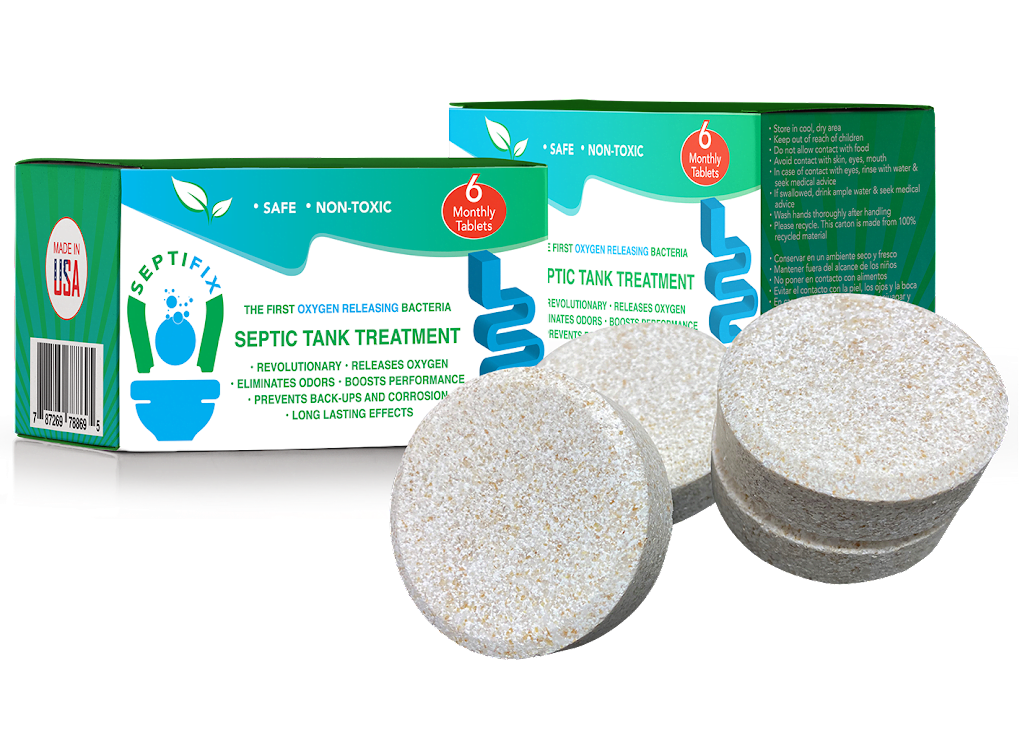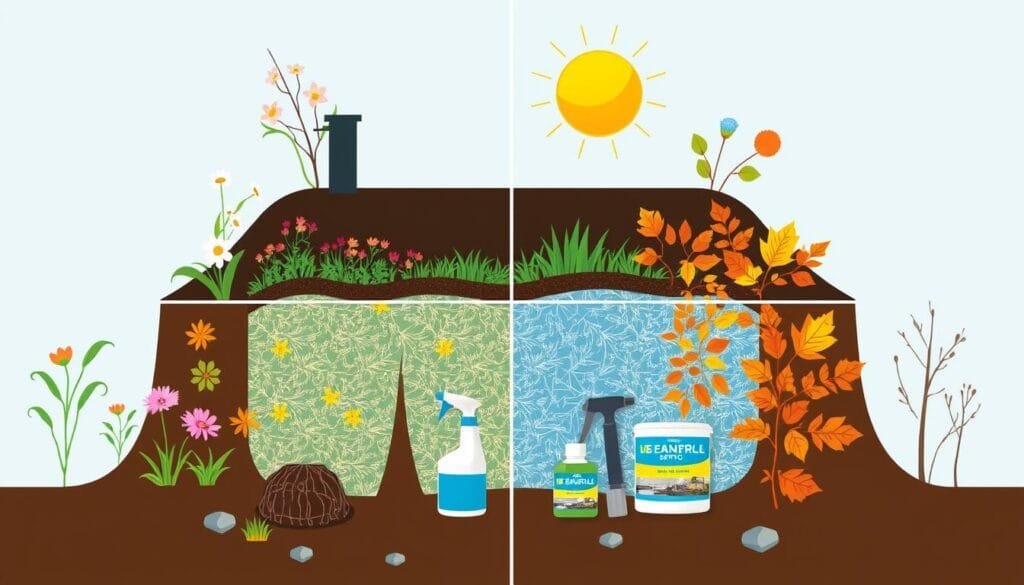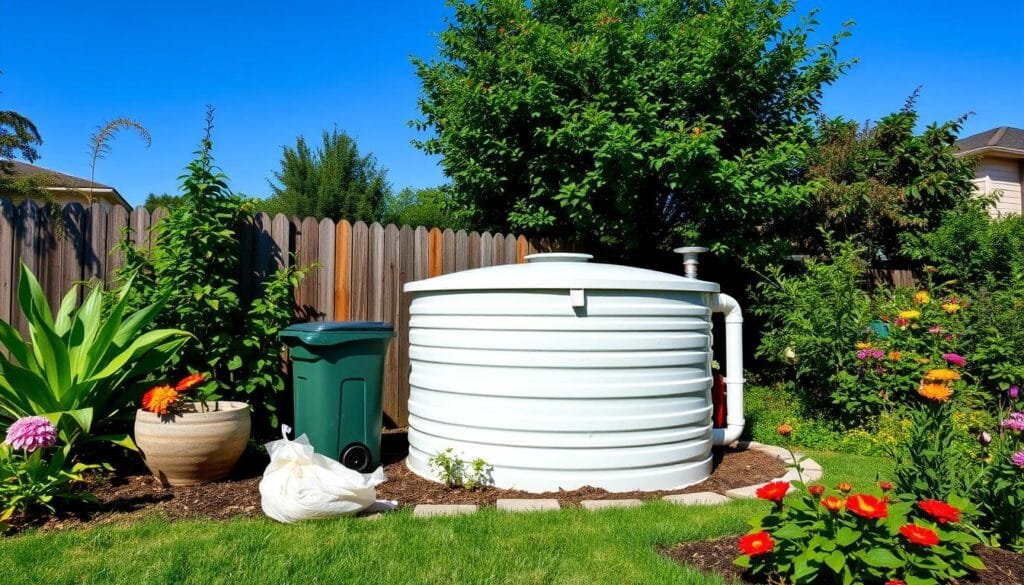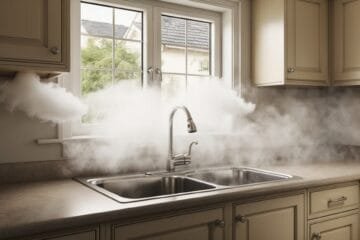Did you know over 60 million people in the U.S. use septic systems? As a septic tank owner, I know how vital it is to keep it working well. This prevents expensive fixes and protects the environment. The right treatment is key to keeping good bacteria alive and waste broken down.
In this article, I’ll share my insights on the best septic tank treatment options. We’ll look at both chemical and natural solutions. We’ll also discuss bacteria’s role, common problems, and what to consider when picking a treatment. By the end, you’ll know how to keep your septic system running smoothly and avoid future issues.
Key Takeaways
- Septic tanks need a mix of aerobic and anaerobic bacteria to work well.
- Common problems include clogs, backups, bad smells, and slow drains.
- RID-X is a top-rated treatment, and natural options like hot water and vinegar work too.
- Regular maintenance, like pumping and proper waste disposal, is key to avoiding issues.
- When choosing a treatment, consider your system type, tank size, household size, and environmental impact.
Exploring septic tank treatments shows the importance of proactive maintenance. The right treatment and best maintenance practices keep your system efficient for years, saving you time, money, and stress in the long run.
Understanding Septic Tank Systems and Their Importance
As a homeowner, I’ve learned how vital septic systems are. They handle household waste well. Septic tanks are key, breaking down waste through bacterial decomposition.

SEPTIFIX will save you hundreds, if not thousands of dollars each year, because your septic system will run smoothly and you won’t have to worry about calling the pumpers or a plumber for a fix!
Click here to save up to 50%
Septic tank bacteria are heroes. They eat and digest waste, keeping the system working. Without them, waste would build up, causing big problems.
| Septic System Type | Advantages | Disadvantages |
|---|---|---|
| Traditional Septic Systems |
|
|
| Chamber Septic Systems |
|
|
| Biofilters (e.g., Ecoflo) |
|
|
| Aerobic Treatment Units (ATUs) |
|
|
The process also releases dangerous gases, like methane. Regular maintenance and treatment are key to keeping the system working well and our environment safe.
Septic systems are often the best choice for wastewater treatment from public health, environmental, and economic standpoints, especially in rural areas where connecting to a centralized sewer system may not be feasible.
Understanding septic systems and their importance has made me value maintenance. By taking care of my system and promoting good bacteria, I help the environment. This keeps my waste management system working well.
Common Issues Faced by Septic Tank Owners
As a septic tank owner, I’ve faced many challenges. These include clogged tanks, bad smells, and slow drains. If not fixed quickly, these problems can turn into big headaches. Let’s look at some common issues and how to solve them.
Clogs and Backups
Clogs and backups are big problems for me. They can happen for many reasons, including sludge buildup, tree roots, or flushing the wrong things.
When my septic tank clogs, I must act fast. This prevents damage and keeps the environment safe.

SEPTIFIX will save you hundreds, if not thousands of dollars each year, because your septic system will run smoothly and you won’t have to worry about calling the pumpers or a plumber for a fix!
Click here to save up to 50%
Recent studies show the #1 reason for septic failure is lack of maintenance. This shows how important regular care is to avoid big problems.
Foul Odors
Foul smells from the tank or drain field are common. These smells mean there’s a problem in the tank’s ecosystem. This can be due to too many bacteria or harsh chemicals.
To fix this, regular maintenance and safe products are needed. This keeps the tank healthy and smell-free.
Slow Drainage
Slow drains are another big problem. They can cause toilets to flush slowly, sinks to back up, or showers to overflow. In my experience, this is usually caused by blockages or a bad drain field.
| Issue | Potential Causes | Warning Signs |
|---|---|---|
| Clogs and Backups |
|
|
| Foul Odors |
|
|
| Slow Drainage |
|
|
By quickly fixing these problems, I keep my septic system working well. Regular care and using treatments like DOWN JOHN™ help avoid expensive fixes, keeping my tank working for a long time.
The Role of Bacteria in Septic Tank Maintenance
As a septic tank owner, I’ve learned how important bacteria are. They grow naturally in the tank. These good microbes break down waste and keep the system working well.
There are two main types of bacteria in septic tanks: aerobic and anaerobic. Each type has a special job in breaking down waste and needs different conditions to work best.
Aerobic Bacteria
Aerobic bacteria need oxygen and live in the tank’s top layer. They break down food scraps, fats, and oils. They work best when the temperature is between 77 and 95 degrees Fahrenheit.
Anaerobic Bacteria
Anaerobic bacteria don’t need oxygen and live in the tank’s bottom. They break down proteins, starches, and other hard-to-process compounds.
| Bacteria Type | Oxygen Requirement | Location in Tank | Organic Matter Breakdown |
|---|---|---|---|
| Aerobic Bacteria | Requires Oxygen | Upper Layer | Food Scraps, Fats, Oils |
| Anaerobic Bacteria | Does Not Require Oxygen | Lower Layers | Proteins, Starches, Complex Compounds |
To keep bacteria balanced, avoid harsh chemicals. Also, don’t flush items like wipes, diapers, and coffee grounds, as they can harm the system.
Regular maintenance and inspection of properly designed and installed septic systems prevent failure and extend system life.
Some products claim to help with septic tanks. But always ask an expert before using them. Knowing about aerobic and anaerobic bacteria helps keep your tank healthy for years.

SEPTIFIX will save you hundreds, if not thousands of dollars each year, because your septic system will run smoothly and you won’t have to worry about calling the pumpers or a plumber for a fix!
Click here to save up to 50%
What’s the Best Septic Tank Treatment?
Choosing the best septic tank treatment is key for your system’s health. I’ve found two top picks: RID-X and natural methods like hot water, vinegar, and baking soda.
RID-X Septic Tank Treatment
RID-X is a favorite among septic users. It has special bacteria that break down waste and paper. Regular use prevents clogs and bad smells, keeping your system working well.
Using RID-X is easy. Just flush the packets down your toilet monthly. It works for tanks from 500 to 1,500 gallons, fitting most homes.
| Tank Size | Monthly Dosage |
|---|---|
| 500-1,500 gallons | 1 packet |
| 1,500+ gallons | 2 packets |
Natural Remedies: Hot Water, Vinegar, and Baking Soda
For a natural fix, try hot water, vinegar, and baking soda. These ingredients break down grease and oils in your pipes and tank.
Start by pouring boiling water down your drains. Then mix 1 cup of vinegar and 1 cup of baking soda. Let it sit for a few hours or overnight. Flush with more boiling water. Do this every 3-6 months to keep your system running well.
I’ve been using the hot water, vinegar, and baking soda method for years, and it’s helped me avoid costly repairs and maintenance issues with my septic tank.
Natural remedies are good, but they might not be as strong as RID-X. For the best results, mix natural methods with a commercial treatment like RID-X.
Benefits of Regular Septic Tank Treatment
As a homeowner, I know how vital it is to keep my septic system healthy. Regular treatment has many benefits. It keeps my system working well and avoids expensive repairs later. Using a top-notch septic tank treatment like PORT helps a lot.
- Efficient waste breakdown: Regular treatment breaks down the solid waste, preventing clogs and backups.
- Odor reduction: It balances the tank, cutting down on foul smells.
- Extended septic system lifespan: It keeps the system running smoothly, making it last longer.
- Environmental benefits: PORT is eco-friendly, keeping harmful chemicals out of the environment.
Septic systems need regular care because they’re delicate and complex. Many things, like solid waste buildup and tree roots, can affect their efficiency. A monthly treatment helps manage these issues.
Applying a monthly septic tank treatment is key to maintaining a healthy septic system.
PORT is a standout septic tank treatment. Thanks to its natural ingredients, it’s safe and effective. It clears tough waste and extends the time between tank pumpings. Plus, being a USDA Certified BioBased Product® is good for the environment.
| Septic Tank Treatment Benefit | How PORT Achieves It |
|---|---|
| Efficient waste breakdown | Clears bio-solids and digests grease, feminine hygiene products, and other difficult compounds |
| Odor reduction | Eliminates unpleasant odors emitted from septic systems |
| Extended septic system lifespan | Can add years between septic tank pumpings by maintaining optimal performance |
| Environmental benefits | All-natural, safe for families and pets, and a USDA Certified BioBased Product® |
Using PORT regularly is a smart move for my septic system. It keeps my system running well and lasts longer. By joining the Pour the PORT program, I get regular treatment and peace of mind.

SEPTIFIX will save you hundreds, if not thousands of dollars each year, because your septic system will run smoothly and you won’t have to worry about calling the pumpers or a plumber for a fix!
Click here to save up to 50%
Factors to Consider When Choosing a Septic Tank Treatment
When picking a septic tank treatment, think about a few key things. Knowing these can help your septic system work better and last longer. As someone who owns a septic tank, I’ve found that these tips really help.

Septic System Type
The type of septic system you have matters a lot. Different systems need different treatments. For example, biological treatments are great for breaking down solids and keeping the environment safe.
Tank Size
The size of your septic tank is also important. A bigger tank needs more treatment, but too much in a small tank can upset the system. Always follow the treatment instructions based on your tank size.
Household Size
The number of people in your home affects your septic system. More people mean more waste. So, you might need to treat your septic more often. Treatments should be adjusted based on your household size.
Environmental Impact
It’s important to choose treatments that are good for the environment. Biological treatments are the best because they’re natural and safe. Avoid treatments that can harm the soil and water.
Choosing the right septic tank treatment is not a decision to be taken lightly. By carefully considering your septic system type, tank size, household size, and the treatment’s environmental impact, you can ensure the best possible care for your septic system and the surrounding environment.
| Treatment | Waste Elimination | Residue Left | Formulation | Active Ingredient Concentration | Ease of Use |
|---|---|---|---|---|---|
| FLUSHTIME | 97% | Minimal | Biological (50+ billion bacteria) | High | Easy (capsule) |
| Green Gobbler | 70% | Moderate | Biological | Medium | Moderate (liquid) |
| Cabin Obsession | 63% | Moderate | Biological | Medium | Easy (pod) |
| GreenPig | 53% | Moderate | Biological | Low | Moderate (powder) |
| Rid-X | 47% | High | Chemical | Low | Easy (pod) |
Think about these factors and pick a good treatment like FLUSHTIME. It contains over 50 billion beneficial bacteria in one capsule. Regular care, like inspections and pumping, is also key to keeping your system working properly.
Chemical vs. Natural Septic Tank Treatments
Choosing between chemical and natural septic tank treatments is important. It keeps your septic system working well and keeps your family and the environment safe. As a homeowner, I know how crucial it is to make the right choice.
Chemical treatments contain harsh ingredients like alkalis and acids. They quickly break down waste but can harm the good bacteria in your septic system, which are key to breaking down organic matter.
On the other hand, natural treatments use enzymes and bacteria to break down waste naturally. They support the good bacteria in your septic tank, keeping your system working well without harming the environment or your family.

SEPTIFIX will save you hundreds, if not thousands of dollars each year, because your septic system will run smoothly and you won’t have to worry about calling the pumpers or a plumber for a fix!
Click here to save up to 50%
“I’ve been using natural septic tank treatments for years, and I can confidently say that they’ve made a significant difference in the health and longevity of my septic system. Not only do they keep things running smoothly, but I also have peace of mind knowing that I’m not introducing harmful chemicals into the environment.”
Natural treatments may take longer to work than chemical ones. But they are safer and better for the environment in the long run. Choosing natural treatments means you’re investing in your septic system’s health and your family’s well-being.
| Chemical Septic Tank Treatments | Natural Septic Tank Treatments |
|---|---|
| Contain harsh ingredients like alkalis and acids | Use enzymes and bacteria to break down waste naturally |
| Can harm beneficial bacteria in the septic system | Support and enhance the existing bacterial ecosystem |
| Provide quick results but may be detrimental in the long run | Take longer to work but are safer and more sustainable |
| Can potentially harm the environment and your family | Eco-friendly and safe for households |
The choice between chemical and natural treatments depends on your needs and values. As someone who cares about their septic system and the environment, I recommend natural treatments whenever you can.
Frequency of Septic Tank Treatment
Keeping your septic system healthy is key. Finding the right mix of natural and chemical treatments is crucial. This balance helps your septic tank work well, avoiding expensive fixes and bad smells.

Natural Treatments: Every 3-6 Months
Natural treatments are good for the planet. They add good bacteria to your septic system. This helps break down waste and keeps things running smoothly. I suggest using natural treatments every 3-6 months to keep the bacteria balance right.
The exact time you need to treat your septic tank depends on a few things:
- Household size
- Water usage
- Tank size
- Septic system condition
Chemical Treatments: Follow Manufacturer Instructions
Chemical treatments can fix issues like clogs. But, it’s important to use them as the maker says. Using too much can upset the balance of bacteria in your tank, causing more problems.
Here’s what to do with chemical treatments:
- Always read the label and follow the dosage and frequency advice.
- Don’t use chemical treatments too often. It can hurt the good bacteria.
- Switch between chemical and natural treatments to keep your septic system healthy.
To find the best treatment schedule for your home, think about these things:
| Factor | Impact on Treatment Frequency |
|---|---|
| Household size | Bigger homes might need treatments more often because of more waste. |
| Water usage | Using too much water can fill up the tank, needing more treatments. |
| Tank size | Smaller tanks need more treatments because they can’t hold as much. |
| Septic system condition | Old or neglected systems might need more treatments to stay working. |
Keeping your septic system in good shape is vital for your health and the planet’s. By sticking to a regular maintenance plan and using the right treatments, you can avoid big expenses and keep your system working well for a long time.
Safe Application of Septic Tank Treatment
Keeping your septic system healthy is crucial. Always follow the manufacturer’s instructions for treatment. This ensures the right amount and frequency for your tank and household sizes.
EPA-approved septic tank bacteria starters are best. These treatments boost natural bacteria, breaking down waste efficiently. However, not all drain cleaners are good for septic systems. Always check before buying.
Choosing the right septic tank treatment is crucial for preventing costly repairs and system failures. By investing in regular, safe treatments, I’ve been able to maintain a healthy septic system and avoid major issues down the line.
Here are some tips for septic system care:
- Pumping the septic tank every 3-5 years to remove accumulated sludge and scum
- Being mindful of what goes down the drain and only flushing toilet paper and human waste
- Promptly addressing any leaks or damage to the system to prevent further complications
Many septic tank treatments include powders, liquids, pods, and tablets. Each has its own benefits and things to consider. It’s important to pick the one that fits your needs and preferences.
| Treatment Form | Advantages | Considerations |
|---|---|---|
| Powder | Easy to measure and dispense | Can be messy and may require mixing |
| Liquid | Quick to apply and disperses evenly | May require more frequent application |
| Pods | Pre-measured doses for convenience | Can be more expensive per treatment |
| Tablets | Slow-release for long-lasting effects | May not dissolve evenly in the tank |
Follow these tips and use safe treatments to ensure your septic system works well. Regular care helps avoid expensive repairs. A little effort now can save a lot of money later!
Additional Tips for Maintaining a Healthy Septic System
Keeping my septic system healthy is a big job. I use the best septic tank treatment and follow some key tips. These steps help avoid expensive repairs and keep my septic tank working well for longer.

Regular Pumping
Regular pumping is key to septic tank care. Homes need to pump their septic systems every three to five years. This removes solids and costs between $300 and $600, depending on the tank size.
I make sure to pump my system regularly. This prevents clogs and backups.
Proper Waste Disposal
I’m careful about what I flush down the toilet and drain. Only toilet paper made for septic tanks is okay. I avoid flushing items like feminine hygiene products, cigarette butts, and paper towels.
I don’t put grease, coffee grounds, or food waste down the kitchen drain. These can cause clogs and harm the septic system.
Various cleaning products used at home, like bleach and drain cleaners, can harm the good bacteria in a septic system.
Leak Repair
Fixing leaks quickly is vital for septic system maintenance. Even small leaks can strain the system and cause bigger problems if not fixed. I often check my plumbing and septic system for leaks and fix them immediately.
Professional Inspections
I also get professional inspections every three to five years. A skilled technician can spot issues and advise on keeping the system healthy. They check the tank, drain field, and other parts to make sure everything is working properly.
| Septic System Maintenance Task | Frequency |
|---|---|
| Regular pumping | Every 3-5 years |
| Professional inspections | Every 3-5 years |
| Leak repair | As needed |
My septic system stays healthy by using the best septic tank treatment and following these tips. Regular care prevents expensive repairs and keeps the environment safe by avoiding septic failures and groundwater pollution.
Conclusion
My search for the best septic tank treatment taught me a lot. Keeping a septic system healthy is key for our planet and homes. With over 1,200 additives out there, picking the right one is vital. Learning how septic tanks work showed me why regular care is so important.
Natural helpers like hot water, vinegar, and baking soda work well for upkeep. However, chemical treatments need careful use. Choosing green options is better for our planet and keeps the system balanced.
Regular pumping, proper waste handling, and fixing leaks are also crucial. Getting professional checks helps, too. This all keeps the system running smoothly.
Now, I know how to pick the best treatment for my system. It should fix problems like clogs and smells. A well-kept septic system means a cleaner home and helps protect our water.
FAQ
What are the different types of bacteria in septic tanks?
Septic tanks have two kinds of bacteria. Aerobic bacteria need oxygen and live in the top layer. They break down food scraps, fats, and oils. Anaerobic bacteria don’t need oxygen and live in the bottom. They break down proteins, starches, and other complex compounds.
How often should I treat my septic tank?
How often to treat your septic tank varies. It depends on tank size, household size, and treatment type. Natural treatments need adding every 3-6 months. Chemical treatments should be added once a month or every few months, as the label says.
What is the best septic tank treatment product?
RID-X is a top choice for septic tank treatment. It has special bacteria for breaking down organic matter. You can also use natural items like hot water, vinegar, or baking soda to help your septic system.
What are the benefits of regular septic tank treatment?
Regular treatment keeps waste breaking down well. It prevents clogs, reduces odors, and makes your system last longer. It’s also good for the environment. Treatments keep the tank’s bacteria balanced, ensuring it works right.
What factors should I consider when choosing a septic tank treatment?
Think about your septic system type, tank size, and household size. Different treatments work better for different systems. Choose one that’s safe for the environment and fits your system.
What are the common issues faced by septic tank owners?
Owners often deal with clogs, foul odors, and slow drainage. These problems can be expensive and unpleasant. They need quick fixes to avoid bigger issues.
How can I safely apply septic tank treatment?
Know your tank size to use the right amount of treatment. Only use EPA-approved products and follow the instructions. Avoid harsh chemicals. Pump your tank every 3-5 years and only flush toilet paper and human waste.
What are some additional tips for maintaining a healthy septic system?
Pump your tank every 3-5 years and only flush toilet paper and human waste. Fix leaks quickly and get professional checks every 3-5 years. Plant trees at least 20 feet away to avoid damage.


